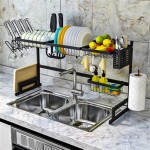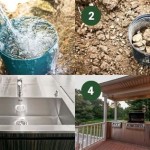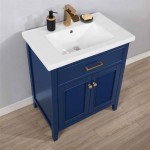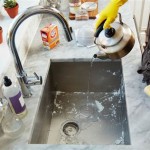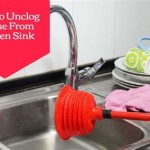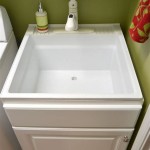How To Open a Sink Pipe: A Comprehensive Guide
A clogged sink pipe can disrupt daily routines, leading to water backup, unpleasant odors, and potential damage to plumbing systems. Addressing a clogged pipe promptly and efficiently is crucial for maintaining a functional and hygienic environment. This article provides a comprehensive guide on how to open a sink pipe, outlining various methods and techniques for resolving common plumbing issues.
Before attempting any plumbing repair, it is essential to prioritize safety. Turn off the water supply to the sink to prevent flooding and potential water damage. Place a bucket or container under the pipes to catch any water that may spill during the process. Wear rubber gloves to protect hands from bacteria and potential contaminants found in drainpipes. Adhering to these safety precautions will minimize risks and ensure a safer working environment.
The initial step in addressing a clogged sink pipe involves identifying the location and severity of the blockage. Common indicators of a clog include slow draining water, gurgling sounds emanating from the drain, and the presence of standing water in the sink. In many cases, the clog is located within the P-trap, the curved section of pipe located beneath the sink. However, clogs can also occur further down the drain line or within the drain opening itself.
Understanding the Sink's Anatomy: Identifying Key Components
Before attempting to open a sink pipe, it is beneficial to understand the basic components that comprise a typical sink drainage system. The sink drain consists of several interconnected parts, each serving a specific function. These components include the strainer, the tailpiece, the P-trap, the drainpipe, and the vent stack. Understanding the function of each component can aid in identifying the source of the clog and choosing the appropriate solution.
The strainer, located at the sink drain opening, is designed to prevent large debris and objects from entering the drainpipe. The tailpiece is the vertical pipe that connects the strainer to the P-trap. The P-trap is a curved pipe that holds water, creating a seal that prevents sewer gases from entering the home. The drainpipe carries wastewater away from the sink to the main sewer line. The vent stack allows air to enter the drain system, ensuring proper drainage and preventing the formation of a vacuum.
Identifying the specific type of sink pipe is also important. While PVC pipes are common due to their affordability and ease of installation, older homes might have galvanized steel or copper pipes. Each material may require different tools and techniques to avoid damage during the unclogging process.
Methods for Clearing a Sink Pipe Clog
Numerous methods can be employed to open a clogged sink pipe, ranging from simple techniques to more involved procedures. The choice of method will depend on the severity and location of the clog. Start with the least intrusive methods and progress to more aggressive techniques if necessary.
Using Boiling Water: For minor clogs consisting of grease or soap buildup, pouring boiling water down the drain can often dissolve the blockage. Heat a large pot of water to a rolling boil and carefully pour it down the drain. Be cautious to avoid splashing and potential burns. Repeat the process several times, allowing a few minutes for the water to work between applications. This method is most effective for simple clogs in straight pipe sections.
Plunging the Drain: A standard cup plunger can be effective for dislodging clogs located near the drain opening. Ensure there is enough water in the sink to cover the cup of the plunger. Create a tight seal around the drain opening and vigorously plunge up and down for several minutes. Remove the plunger and check if the water drains more freely. Repeat the process as needed. For sinks with two basins, seal the second drain opening with a wet cloth or plug to maximize the effectiveness of the plunger on the clogged side.
Baking Soda and Vinegar Solution: This natural and environmentally friendly solution can often break down clogs caused by organic matter. Pour one cup of baking soda down the drain, followed by one cup of white vinegar. The mixture will create a foaming reaction. Let the mixture sit for 30 minutes to an hour. Flush the drain with hot water to clear any remaining residue. Repeat the process if necessary.
Disassembling and Cleaning the P-Trap: This method involves physically removing and cleaning the P-trap, which is a common location for clogs. Place a bucket or container under the P-trap to catch any water. Loosen the slip nuts that connect the P-trap to the tailpiece and the drainpipe. Carefully remove the P-trap and empty its contents into the bucket. Clean the inside of the P-trap with a wire brush or a bent coat hanger to remove any debris. Reassemble the P-trap and tighten the slip nuts, ensuring a watertight seal. Run water to test for leaks.
Using a Plumber's Snake (Auger): A plumber's snake, also known as an auger, is a flexible tool designed to reach deeper into drainpipes and break up or retrieve clogs. Insert the snake into the drain opening and feed it through the pipe until you encounter resistance. Rotate the handle to break up the clog or hook onto it. Carefully retract the snake, removing any debris that is attached. Repeat the process as needed. A variety of plumber's snakes are available, from inexpensive hand-cranked models to more powerful motorized versions. The appropriate type will depend on the nature and location of the clog.
Chemical Drain Cleaners: Chemical drain cleaners are a last resort, as they can be corrosive and potentially damage pipes, especially older or weakened ones. Furthermore, they pose environmental risks and can be hazardous to handle. If other methods have failed, choose a chemical drain cleaner specifically designed for sink pipes and follow the manufacturer's instructions carefully. Wear protective gloves and eyewear, and ensure adequate ventilation. Avoid mixing different types of chemical drain cleaners, as this can create dangerous fumes. After using a chemical drain cleaner, flush the drain thoroughly with water.
Preventive Measures: Maintaining a Clear Drain
Preventing clogs is crucial for maintaining a functional sink drainage system. Implementing simple preventive measures can significantly reduce the frequency of clogs and prolong the lifespan of plumbing components. These measures include maintaining a clean strainer, avoiding the disposal of grease down the drain, and regularly flushing the drain with hot water.
Maintaining a Clean Strainer: Regularly clean the sink strainer to remove any accumulated debris. Food scraps, hair, and other small objects can quickly accumulate in the strainer, restricting water flow and contributing to clogs. Remove the strainer and rinse it under running water. Use a brush or sponge to remove any stubborn debris.
Avoiding Grease Disposal: Grease is a common culprit in sink pipe clogs. When hot grease cools, it solidifies and adheres to the walls of the drainpipe, gradually building up and restricting water flow. Instead of pouring grease down the drain, collect it in a container and dispose of it properly in the trash.
Regular Flushing with Hot Water: Periodically flushing the drain with hot water can help to prevent the buildup of grease and soap scum. Run hot water down the drain for several minutes, especially after washing dishes or using greasy products. The hot water will help to dissolve any accumulated residue and keep the drainpipe clear.
Troubleshooting Common Sink Pipe Issues
Various issues can arise with sink pipes, beyond simple clogs. Understanding common problems can help identify the source of the trouble and facilitate effective solutions. These issues include leaks, slow draining, and unusual noises.
Leaks: Leaks in sink pipes can result from loose connections, damaged pipes, or worn-out washers. Inspect all connections and tighten any loose slip nuts. Replace damaged pipes or washers if necessary. Use plumber's tape to seal threaded connections and prevent leaks.
Slow Draining: Slow draining can indicate a partial clog or a problem with the drain vent. Try using a plunger or a plumber's snake to dislodge any potential clogs. Check the drain vent for any obstructions. A blocked vent can prevent proper drainage by creating a vacuum in the drainpipe.
Unusual Noises: Gurgling sounds emanating from the drain can indicate a blockage or a problem with the drain vent. Check for clogs and ensure the drain vent is clear. Loud banging noises, known as water hammer, can be caused by sudden changes in water pressure. Install water hammer arrestors to absorb the shock and prevent damage to plumbing pipes.
When dealing with persistent or complex plumbing issues, consulting a qualified plumber is recommended. Attempting repairs beyond one's skill level can lead to further damage and increased costs. A professional plumber possesses the expertise and specialized tools to diagnose and resolve plumbing problems effectively and safely.
Tools and Materials Required
Having the right tools and materials readily available can streamline the process of opening a sink pipe and ensure efficient repairs. Essential tools include:
* Bucket and container * Rubber gloves * Adjustable wrench * Plunger * Plumber's snake (auger) * Screwdriver * Wire brush * Plumber's tape * Replacement pipes and washers (if needed)Preparing a dedicated plumbing toolkit and keeping it accessible can save time and effort when addressing plumbing issues.

How To Unclog A Sink The Right Way

How To Remove A Kitchen Sink Drain 13 Steps With Pictures

How To Get Something Out Of A Sink Drain Punctual Plumber Dallas

How To Unclog A Bathroom Sink Hana S Happy Home

How To Clean A P Trap Or U Bend 10 Steps With Pictures

How To Open Up A Slow Sink Drain Clog Remove P Trap And Stopper

Solved How To Cap Unused Open Sink Pipes And Wa Bunnings Work Community

Getting A Watertight Seal On The Sink Drain Assembly

4 Simple Ways To Fix A Leaky Sink Drain Pipe Wikihow

How To Easily Connect The Plumbing For A New Bathroom Sink Hometips
